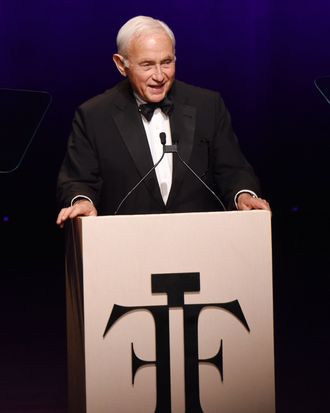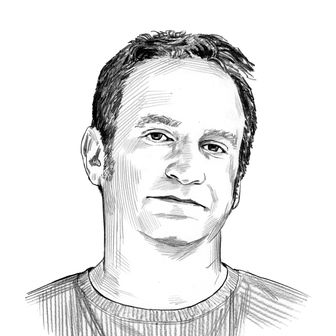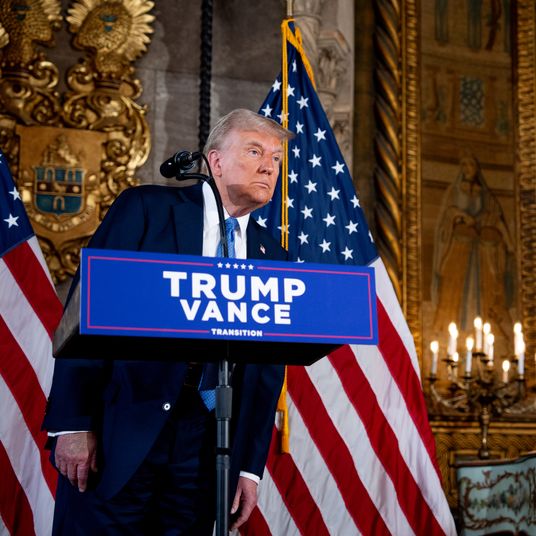
One of the enduring mysteries of the Jeffrey Epstein case is how, exactly, a former high-school math teacher transformed himself into a financier worth hundreds of millions of dollars. At the center of that conundrum is Les Wexner, the CEO of L Brands, which controls mall staples like Victoria’s Secret, Pink, and Bath & Body Works. Wexner was Epstein’s central client for years; he granted Epstein an enormous amount of trust and authority. But the bond between the two men has always been shrouded in mystery.
“It’s a weird relationship,” one Wall Streeter who reportedly knew Epstein told New York for its profile of Epstein in 2002. “It’s just not typical for someone of such enormous wealth to all of a sudden give his money to some guy most people have never heard of.” That profile also described Wexner as Epstein’s “mentor.”
Two exposés published on Thursday, by the New York Times and the Wall Street Journal, offered more insight into the Epstein-Wexner connection, though they didn’t solve its central mystery. Here are the highlights of what the stories uncovered:
Suspicions About the Relationship Existed From the Beginning
The Times reports that Epstein and Wexner met in Ohio, where the 81-year-old Wexner is based, in the mid-to-late 1980s. They were introduced by insurance executive Robert Meister, a mutual friend. Epstein, who was coming off a stint at Bear Stearns, pitched himself as a tax expert, and Wexner immediately began spending a lot of time with him — though it’s unclear if there was a formal financial arrangement between the two at the time.
Some associates of Wexner were baffled as to why the billionaire would become so enamored of someone who was such an unknown quantity. “I tried to find out how did he get from a high school math teacher to a private investment adviser,” Robert Morosky, the former vice chairman of The Limited, said. “There was just nothing there.”
That did not appear to matter to Wexner, who gave Epstein an increasing share of authority over his finances, to the point that in 1991, he granted his adviser power of attorney, which “enabled Mr. Epstein to hire people, sign checks, buy and sell properties and borrow money — all on Mr. Wexner’s behalf.”
Epstein grew steadily richer over the next few years, but his association with Wexner ended in 2007. Wexner has said he was not aware of Epstein’s alleged criminal activities.
Wexner Prioritized Epstein Over Old Friends
The Times quotes Jim Duberstein, a onetime friend of Wexner’s who had known him for years, as saying that shortly after the Wexner-Epstein bond took hold, Wexner took Epstein’s side over his in a disagreement — then cut him out of his life completely, in what appeared to be a pattern.
“Les Wexner, until the time he quit talking to me, was probably the finest person I ever met in my life,” Duberstein said. He was the most charitable, the most generous, the most understanding. I have nothing but praise for him — until he just cut his umbilical cord.”
Epstein Used His Wexner Connection to Pose as a Victoria’s Secret Scout
Former Victoria’s Secret model Alicia Arden says that Epstein grabbed her and tried to undress her after introducing himself as a talent scout in 1997, a detail that had been previously reported with fewer details. Arden filed a police report, but says that it was not taken seriously.
Two senior executives had also told Wexner around the time of the alleged Arden assault that Epstein was telling people he was a Victoria’s Secret recruiter; it’s not clear if he took any action.
In 1996, Epstein allegedly sexually assaulted Maria Farmer, a woman who was working on an art project Epstein was supervising at Wexner’s Ohio mansion.
Epstein Made Very, Very Good Money From Wexner
The Journal estimates that Epstein’s years controlling Wexner’s finances — including matters like arranging his prenuptial agreement and helping to handle investments, netted him at least $200 million. The Journal puts his entire fortune at more than half a billion dollars.
Wexner Was Not Epstein’s Only Big Client
Though Wexner was the first big fish Epstein handled after he formed his own firm, he wouldn’t be the last; the Wall Street Journal reports that “the bulk of his wealth appears to have come from a small number of very wealthy clients.” Building off his success with Wexner, Epstein began working with Elizabeth Ross Johnson, heiress to the Johnson & Johnson fortune. Once again, Epstein’s life seemed to overlap with a client’s in unusual ways; “Mr. Epstein’s name appears briefly on property records for Ms. Johnson’s home in Vail and several land parcels in Dutchess County, N.Y., north of New York City,” the Journal reports.
Around 1997, Epstein also began working with Leon Black, CEO of the private-equity firm Apollo Management, providing tax strategy to the company’s high-earning clientele. The association appears to have ended about a decade later.
And Epstein made investments in the hedge fund Highbridge Capital, which almost tripled when he directed clients their way.






























